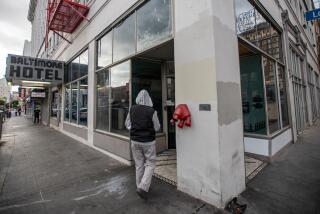S&L; Agency to Sell Real Estate Assets at ‘Measured Pace’
- Share via
WASHINGTON — The sale of billions of dollars in real estate from defunct savings and loan associations may take several years, preventing any dumping of properties that might depress local markets, federal officials said Wednesday.
The government will dispose of real estate assets “at a measured pace,” said Daniel P. Kearney, president of the federal Oversight Board, which on Wednesday issued its strategic plan for handling the financial cleanup of hundreds of crippled S&Ls.;
Kearney’s plan provides an operating blueprint for the Resolution Trust Corp., which controls 281 ailing S&Ls; with $104 billion in assets. The Oversight Board sets policy for the RTC, an agency created last year to manage asset sales of failed thrifts. About 25% of the assets are in Texas, which suffered the largest number of S&L; failures.
Kearney’s statements represented the government’s first formal acknowledgement of the pace at which it will sell real estate assets. Real estate experts and others nationwide have expressed concerns that the government, anxious to dispose of the assets as quickly as possible, might go too fast and dramatically disturb already depressed local real estate markets.
The assets available for sale “range from cash to mortgage-backed securities to houses to Pizza Hut parlors,” Kearney said. Mortgage loans and securities backed by mortgages can be sold relatively quickly to investors because the market for these products is “extremely large,” he said.
But the real estate--office buildings, single-family homes, shopping centers and stores, condominiums and unimproved land--may take much longer even if the government moves “with all deliberate speed,” he said.
Legal problems connected to the real estate “will necessitate a lengthy period of real estate asset sales stretching over several years,” Kearney said. “When the RTC has an asset ready for sale, it should offer it for sale--at a measured pace.”
The RTC issued its first inventory list Tuesday, a massive compilation of 30,000 properties covering nearly 3,000 pages.
Real estate assets make up about $45 billion to $50 billion of the assets at the 281 S&Ls; under government control. An additional 200 institutions are having financial difficulties and are likely targets for government takeover. This would add billions of dollars more to the tally of real estate properties that will eventually be sold by the government.
“The task facing the RTC for asset disposition is unprecedented in magnitude and complexity,” Kearney noted. The tally of 30,000 pieces of real estate “does not take into account mortgage loans, servicing rights or securities,” he said.
The strategic plan directs the RTC to “rely heavily on the private sector” in disposing of financial and real estate assets, the Oversight Board said in its summary description of the plan. Real estate agents, auctioneers and other business persons would be involved in helping dispose of assets.
“Contractors should be given incentives to generate the best possible return on assets, but RTC should develop measures that discourage contractors from speculating by holding properties too long,” the Oversight Board said.
The strategic plan says the government should move quickly to stem the continuing financial losses at the S&Ls; under its control. The RTC was given a deadline of Jan. 15 to develop a system to measure “the rate of deterioration of each insolvent institution and the financial risk each poses to the government,” the Oversight Board said.
Then the RTC should develop standards to decide which institutions to target for immediate shut-down or sale. The RTC has $50 billion to dispose of failed institutions, either by paying off depositors, whose accounts are insured up to $100,000, or finding outside investors to buy the institutions.
Under the strategic plan, the RTC would be permitted to offer capital to some prospective buyers to finance their purchases of defunct S&Ls.; This drew sharp criticism from Rep. Bruce Vento (D-Minn.), chairman of a special House Banking Committee task force dealing with oversight of the S&L; cleanup.
The sale of S&Ls; “should be subject to a market test,” with prospective buyers arranging their own financing, Vento said. The RTC “should not gamble with the taxpayers’ money,” Vento said. He also expressed concern that the Oversight Board did not provide details of policies dealing with possible conflicts of interests among persons dealing with the RTC.
More to Read
Inside the business of entertainment
The Wide Shot brings you news, analysis and insights on everything from streaming wars to production — and what it all means for the future.
You may occasionally receive promotional content from the Los Angeles Times.










